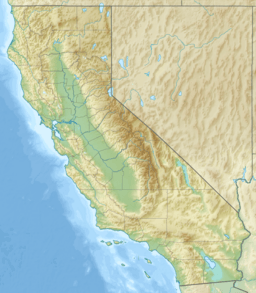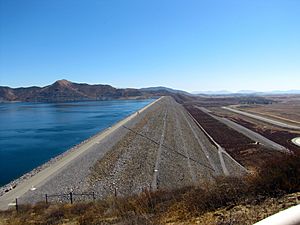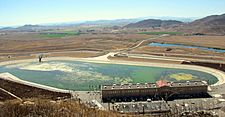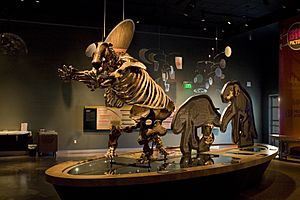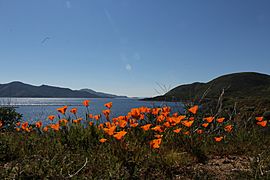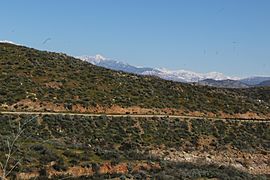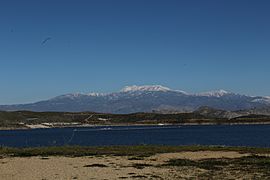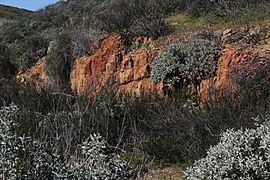Diamond Valley Lake facts for kids
Quick facts for kids Diamond Valley Lake |
|
|---|---|
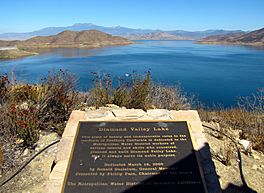 |
|
| Location | Riverside County, California, United States |
| Coordinates | 33°40′42″N 117°02′30″W / 33.67833°N 117.04167°W |
| Lake type | Reservoir |
| Basin countries | United States |
| Max. length | 4.5 mi (7.2 km) |
| Max. width | 2 mi (3 km) |
| Surface area | 4,500 acres (1,800 ha) |
| Max. depth | 260 ft (79 m) |
Diamond Valley Lake is a huge, man-made lake near Hemet, California, in the United States. It's one of the biggest and newest lakes in Southern California. This lake is super important because it stores a lot of water for people in the area. It helps make sure there's enough water during dry times, hot summers, or emergencies.
The Metropolitan Water District of Southern California (MWD) started building this lake in 1995. It cost about $1.9 billion! Water began filling the lake in 1999, coming from the Colorado River Aqueduct. The lake was completely full by 2003. Today, the lake gets its water from the Inland Feeder.
Diamond Valley Lake has three giant earth dams. Two are on the sides of the valley, and one is on the north rim. Builders used materials found nearby to construct these dams. This was one of the biggest earth-moving projects in the United States! While digging for the dams, workers found many amazing fossils. You can see all these fossils at the Western Science Center near the lake's east end. The lake is a great place for boating, fishing, hiking, and other fun outdoor activities.
Contents
Where is Diamond Valley Lake?
Diamond Valley Lake is located in the Domenigoni/Diamond valleys. It sits between the Domenigoni Mountains and Rawson Mountains. This is about 4 miles (6.4 km) southwest of Hemet, California. The spot was chosen because it's between the big cities of San Diego and Los Angeles. Also, there were plenty of natural materials nearby to build the three dams. It's also only about 5 miles (8 km) from the Colorado River Aqueduct, which brings water to the lake.
How Was the Lake Built?
Planning for Diamond Valley Lake started way back in 1987. The main goal was to store water for Southern California. This water would be used for different seasons, during droughts, and for emergencies. The MWD picked this spot and began planning the construction in 1993.
Building the lake started in 1995 with the three dams. This project involved moving over 40 million cubic yards (30.6 million m³) of dirt for the foundations. Then, 110 million cubic yards (84 million m³) of earth were used to build the dams themselves. This made it the largest earth-moving project in the United States at the time! The giant shovels, loaders, and trucks used were some of the biggest ever. They set new records for moving earth and rock. Two rock processing plants were set up just for this project. They produced more material than any other single commercial plant in California. Building this lake was the biggest construction project for the MWD since they built the Colorado River Aqueduct.
At its busiest in 1997 and 1998, about 1,800 people worked on the reservoir project every day. Sometimes, more than 1,900 people were busy building the dams. From start to finish, around 5,000 people helped build Diamond Valley Lake.
The Giant Dams
The three dams were finished in 1999. To build them, workers had to dig out 31 million cubic meters (40.5 million cu yd) of dirt for the foundations. The earth fill dams needed about 110 million cubic yards (84 million m³) of sand, clay, and rock. Most of these materials came from the area around the lake. The clay and sand came from the valley floor. The rock came from the bedrock hills on the lake's south side.
Engineers designed and built the dams to be safe from earthquakes. The San Jacinto Fault Zone is very close, and the San Andreas Fault is about 19 miles (30.6 km) away.
West Dam
The West Dam is 285 feet (87 m) tall, rising above the valley floor. It stretches for 1.5 miles (2.4 km) across a flat valley. About 65% of the dam's base sits on strong bedrock. The rest is on dense soil that fills three old, buried river channels. These channels are up to 120 feet (37 m) deep. Workers dug 90 feet (27 m) below the original ground to remove soft soils. These soils could have made the dam unstable during an earthquake.
To stop water from leaking through the soil, thick walls of special concrete were built. These walls are 3 feet (0.9 m) thick and go across the three old river channels. They were dug at least 2 feet (0.6 m) into the bedrock. To stop leaks through the rock foundation, the entire base was filled with a special liquid called grout. A double curtain of grout was also put in, going down about 125 feet (38 m). Grouting the West Dam took about two years. It needed 189 miles (304 km) of grout holes!
East Dam
The East Dam is 2.1 miles (3.4 km) long, making it the longest of the three dams. It is 1,200 feet (366 m) wide at the bottom and 40 feet (12 m) wide at the top. Before building the dam, over 18 million cubic yards (13.8 million m³) of soil had to be dug out to reach solid bedrock.
The dam needed 43 million cubic yards (33 million m³) of crushed rock. A rock-crushing plant on site crushed over 14 million tons of rock in 20 months to supply the dam. A special concrete wall, 3 feet (0.9 m) thick, was built through the bedrock. It goes from 10 feet (3 m) to 110 feet (34 m) deep. A double curtain of grout also goes down 150 feet (46 m) in the north part of the East Dam and 100 feet (30 m) in the south part.
Because so much material was used, some of the biggest trucks in the world helped build the East Dam. Twelve Caterpillar 789 dump trucks were used!
Saddle Dam
The Saddle Dam is 130 feet (40 m) tall at its lowest point. It is about 0.5 miles (0.8 km) long. This dam was built to make the lake hold more water. Without it, the lower ridge in this area would have limited the lake's size. It is built entirely on strong bedrock. To stop water from leaking, a double grout curtain goes down about 100 feet (30 m) below the foundation.
Filling the Lake with Water
Water began filling Diamond Valley Lake in 1999. It came from the Colorado River Aqueduct and the San Diego Canal. First, the water entered a smaller basin called the forebay. This forebay is about 35 acres (14 ha) big. From there, the water was pumped into the main lake.
The pumping station, named after Hiram W. Wadsworth, has twelve powerful 6,000 horsepower pumps. These pumps move water from the forebay to the intake-outlet (I/O) tower. In 2001, four of these pumps were changed to also produce hydroelectric power. Each one can make 3 megawatts of electricity! If all the pumps were changed, the station could make up to 40 megawatts of power.
Water is pumped from the station, which is near the west dam. It travels through a 2,000-foot (610 m) long, 16-foot (4.9 m) wide pipe into the lake through the I/O tower. At its fastest, water flowed into the lake at 1,000 cubic feet (28 m³) per second. The lake was completely full by 2003.
In 2009, the lake started getting water from the Inland Feeder. This happened after almost two years without a new water source. The new water helped refill the lake after a drought. Water from the Colorado River Aqueduct is not used anymore because of the Quagga mussel. This tiny invasive species has already gotten into other Southern California lakes.
Amazing Fossil Finds
While digging for the lake, workers found many bones and skeletons! These belonged to ancient animals like mastodons, mammoths, camels, sloths, dire wolves, and long-horned bison. Paleontologists are scientists who study fossils. Scientists from the San Bernardino County Museum found thousands of fossils in the Diamond and Domenigoni valleys. These discoveries teach us a lot about the region's past. All these animal fossils together are called the Diamond Valley Lake Local Fauna.
The fossils found here give us a special look at Southern California during the Ice Ages. They help fill in gaps between other fossil sites, like the famous La Brea Tar Pits in Los Angeles. People sometimes unofficially call the Diamond Valley Lake area the "Valley of the Mastodons." The fossils found here are from the late Pleistocene Epoch (Ice Age). They include many extinct animals like:
- Jefferson's ground sloth, Megalonyx jeffersonii
- Harlan's ground sloth, Paramylodon harlani
- Dire wolf, Canis dirus
- Giant short-faced bear, Arctodus simus
- Sabre-toothed cat, Smilodon fatalis
- American lion, Panthera leo atrox
- American mastodon, Mammut americanum
- Columbian mammoth, Mammuthus columbi
- Western horse, Equus occidentalis
- Small horse, Equus conversidens
- Flat-headed peccary, Platygonus compressus
- “Yesterday’s” camel, Camelops hesternus
- Ancient bison, Bison antiquus
- Long-horned bison, Bison latifrons
- Diminutive Pronghorn, Capromeryx minor
Scientists also found many fossils of rabbits, rodents, pond turtles, coyotes, deer, and even black bears. One of the most common animals found was the extinct American mastodon. Mastodons were thought to be forest-dwelling animals that ate leaves and branches. Finding so many mastodon fossils here suggests that during the last Ice Age, the Diamond Valley Lake area had more woods or forests than it does today. Fossils of pine trees and manzanita plants found here support this idea. Dating of the plant fossils shows they are between 13,000 and 60,000 years old.
Fun Things to Do at the Lake
Diamond Valley Lake is a great place for fishing and light boating. There's a recreation park, an aquatic center, a visitor center, and the Western Science Center all located on the east side of the lake. On the west side, there's a viewpoint where you can see the pumping station, the I/O tower, and most of the lake.
South of the lake is the Southwestern Riverside County Multi-Species Reserve. This is a huge 13,500-acre (5,463 ha) nature preserve between Diamond Valley Lake and Skinner Reservoir. It's home to at least 16 rare, endangered, or threatened native California birds, animals, and plants.
Fish were put into the lake even before it was full! A small pond was placed at the bottom of the valley to raise fish. The lake now has several types of freshwater fish, including largemouth bass, smallmouth bass, bluegill, crappie, rainbow trout, striped bass, channel catfish, and shad. A small number of flathead catfish were also accidentally introduced. Many people think it's one of the best fishing spots in California!
Much of the land around the lake is still undeveloped. Original plans included big recreation areas on both the east and west ends. These would have had golf courses, campgrounds, swimming lakes, and water parks. The MWD still hopes to build more fun facilities, but they need more funding and support from developers to do so.
Gallery
-
View of Diamond Valley Lake and California Poppies


